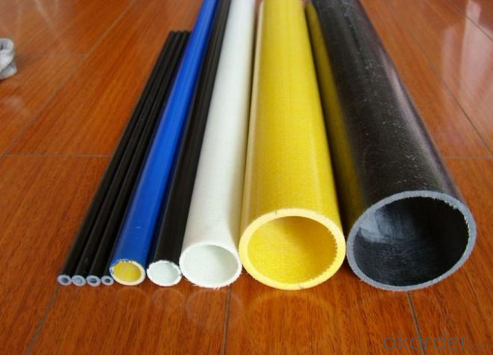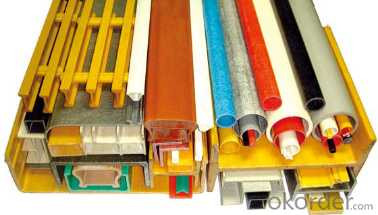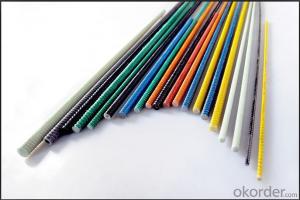FRP Rods and FRP Tubes made in China
- Loading Port:
- Shanghai
- Payment Terms:
- TT OR LC
- Min Order Qty:
- 0 mm
- Supply Capability:
- 20000 mm/month
OKorder Service Pledge
OKorder Financial Service
You Might Also Like
Description of FRP Rods and Tubes
FRP rods and tubes are manufantured by high-strength fiberglass as reinforcing material. thermosetting resin as the base, and then taken shape on a special pultruded mold, where the high temperature activates the resin to cure.
Main Features of FRP Rods and Tubes
light weight and high strength, anti-ageing, aesthetically pleasing appearance, environmental friendliness
Specifications of FRP Rods and Tubes
| Normal size | Φ32*Φ26,Φ32*Φ27.5,Φ32*Φ28,Φ32*Φ22,Φ31*Φ25,Φ30*Φ26,Φ30*Φ24,Φ28*Φ24,Φ28*Φ22,Φ25,.4*Φ20.5,Φ25.4*Φ18.4,Φ24*Φ20,Φ22*Φ18.4 |
| Surface effect | nexus mat surface, continuous strand mat surface, stitched mat surface, painting surface, wood texture surface |
| Regular Color | yellow, red, blue, green, white, gary |
Applications of FRP Rods and Tubes
1.farming tool, shovel, hoe, pickaxe, ax, hammer etc.
2.gardening tool, grass shears, tree pruner, fencing shears, grass harrow etc.
3.cleaning tool, mop, broom, window brush etc.
IMages of FRP Rods and Tubes



FAQ
1. How about the documents after shipment?
After shipment, we ll send all original documents to you by DHL, including Packing List.Commercial Invoice, B/L, and other certificates as required by clients.
2. How long is the delivery time?
Usually it takes 10-25days after receipt of the deposits or L/C, and it also depends on the quantity of your order.
3. How's the payment?
Telegraphic Transfer(T/T) or Letter of Credit(L/C)
4. Do You Arrange Shipment?
Yes, dear esteemed customers, for FOB or CIF price, we will arrange shipment for you. For EXW price, clients need to arrange shipment by themselves or their agents.
5. How is the package?
Usually, we arrange the standard out-package for exporting.
- Q:Are FRP pultrusion profiles resistant to chemicals used in oil refineries?
- FRP pultrusion profiles have a high resistance to chemicals utilized in oil refineries. These profiles consist of a combination of strong fibers (such as fiberglass, carbon fibers, or aramid fibers) embedded in a polymer resin matrix. This unique construction grants them exceptional resistance to various chemicals commonly found in oil refineries. The polymer resin matrix used in FRP profiles can be carefully chosen to withstand harsh chemical environments. For oil refinery applications, vinyl ester or epoxy resins are often employed due to their superior chemical resistance properties. Additionally, FRP pultrusion profiles are inherently corrosion-resistant, unlike traditional materials like steel or concrete that deteriorate when exposed to aggressive chemicals found in oil refineries. This corrosion resistance ensures the long-term durability and reliability of FRP profiles in such environments. Furthermore, FRP profiles offer several other advantages in oil refinery applications, including a high strength-to-weight ratio, electrical insulation, non-magnetic properties, and ease of installation. These characteristics make FRP pultrusion profiles an ideal choice for various structural, piping, and equipment applications within oil refineries. However, it is crucial to consider the specific chemicals and concentrations involved in a particular oil refinery application. While FRP profiles generally exhibit excellent resistance to a wide range of chemicals, there may be highly concentrated or specialized chemicals that could potentially impact their performance. In such cases, it is advisable to seek guidance from FRP manufacturers or experts who can offer tailored solutions to meet the specific chemical resistance requirements of the oil refinery.
- Q:What is the compression strength of FRP pultrusion profiles?
- The compression strength of FRP pultrusion profiles can vary depending on the specific design and manufacturing process. However, on average, FRP pultrusion profiles typically exhibit compression strengths ranging from 20,000 to 40,000 pounds per square inch (psi).
- Q:Are FRP pultrusion profiles resistant to rotting or decaying?
- FRP pultrusion profiles possess a high resistance to rot and decay due to their composition, consisting of a combination of fiber reinforcement, like fiberglass, and a polymer resin matrix. Unlike wood and other conventional materials that rot and decay when exposed to moisture and environmental elements, FRP profiles do not absorb water as they are non-porous. Moreover, the polymer resin employed in FRP exhibits exceptional resistance to chemical corrosion, rendering it impervious to rot-causing agents such as fungi or bacteria. Consequently, FRP pultrusion profiles boast a significantly longer lifespan and necessitate minimal maintenance in comparison to traditional materials, making them an exceptional choice for applications that demand resistance to rot or decay.
- Q:Can FRP pultrusion profiles be used in the construction of wind turbine blades?
- Indeed, FRP pultrusion profiles have the capability to be utilized in the construction of wind turbine blades. There are several advantages offered by FRP pultrusion profiles that render them suitable for this purpose. To begin with, FRP pultrusion profiles possess a lightweight yet robust nature, a crucial characteristic for wind turbine blades since they must endure the aerodynamic forces exerted by the wind. The high strength-to-weight ratio of FRP pultrusion profiles permits the creation of longer and more effective blades. Moreover, FRP pultrusion profiles exhibit exceptional corrosion resistance properties, a vital attribute for wind turbines that are exposed to harsh weather conditions. In contrast to traditional materials like steel, FRP does not corrode, thereby ensuring an extended service life for the wind turbine blades. Additionally, FRP pultrusion profiles are customizable to satisfy specific design requirements. This flexibility allows for the optimization of blade performance by tailoring the shape, thickness, and stiffness of the profiles to maximize energy capture and minimize fatigue. Furthermore, FRP pultrusion profiles possess good fatigue resistance, enabling them to endure repeated loading cycles without experiencing significant performance degradation. This is particularly crucial for wind turbine blades, which encounter cyclic loading due to wind gusts and changes in wind direction. Lastly, FRP pultrusion profiles are electrically non-conductive, a beneficial trait for wind turbine blades as it eliminates the risk of electrical discharge during operation. In conclusion, the lightweight, strong, corrosion-resistant, and customizable nature of FRP pultrusion profiles makes them an outstanding choice for the construction of wind turbine blades. This contributes to the advancement of more efficient and durable wind energy systems.
- Q:Are FRP pultrusion profiles resistant to caustic solutions?
- Yes, FRP (Fiber Reinforced Polymer) pultrusion profiles are generally resistant to caustic solutions. The combination of the reinforcing fibers and the polymer matrix used in FRP pultrusion provide excellent chemical resistance. Caustic solutions, such as strong alkaline substances, can often corrode or degrade traditional materials like steel or wood. However, FRP pultrusion profiles are highly resistant to chemical attack, making them suitable for applications where exposure to caustic solutions is common. This resistance makes FRP pultrusion profiles an ideal choice for industries such as chemical processing, wastewater treatment, and marine environments where corrosive substances are present. Nonetheless, it is important to consult the manufacturer's specifications and guidelines to ensure that specific caustic solutions are compatible with the particular FRP pultrusion profile being used.
- Q:Can FRP pultrusion profiles be used in the construction of shipping containers?
- Yes, FRP pultrusion profiles can be used in the construction of shipping containers. FRP (Fiber Reinforced Polymer) pultrusion profiles offer excellent strength-to-weight ratio, corrosion resistance, and durability, making them suitable for various applications including shipping container construction. These profiles can be used for structural components, such as beams, frames, and panels, to enhance the container's strength and longevity. Additionally, FRP pultrusion profiles can be customized to meet specific design requirements and can withstand harsh environmental conditions typically encountered in shipping and transportation.
- Q:Are FRP pultrusion profiles resistant to vibration or shock?
- FRP pultrusion profiles exhibit high resistance to both vibration and shock. Their exceptional properties, inherent in FRP materials, make them an ideal choice for applications that demand durability and strength in the face of dynamic loading conditions. The composition of FRP profiles typically entails a combination of reinforcing fibers and a resin matrix, resulting in superb stiffness and damping characteristics. As a result, FRP pultrusion profiles effectively absorb and dissipate vibrations and shock forces, effectively preventing damage or degradation. Moreover, the design flexibility of FRP enables tailored reinforcement and optimization, further bolstering their ability to withstand vibration and shock. Consequently, FRP pultrusion profiles prove to be a dependable option for industries such as aerospace, automotive, marine, and structural engineering, where these properties are of utmost importance.
- Q:Plastic or better glass fiber reinforced plastic better?
- Plastic steel profiles referred to as plastic, the main chemical composition is PVC, so also known as PVC profiles. It is a new type of building material which is widely used. Because of its physical properties such as rigidity, elasticity, corrosion resistance and excellent aging resistance, it is usually used as a good substitute for nonferrous metals such as copper, zinc and aluminum.In housing construction is mainly used for the application of push and pull, flat open doors and windows, rails, pipes and ceiling materials, through the process of the new protection board is also widely used in automobile engine, not only light weight, excellent properties and good toughness, stiffness.
- Q:How are FRP pultrusion profiles manufactured?
- FRP pultrusion profiles are manufactured through a highly controlled and precise process. The manufacturing process involves several steps. Firstly, the raw materials are selected, which usually include reinforcing fibers such as fiberglass, carbon fiber, or aramid, and a thermosetting resin matrix. These materials are chosen based on the desired mechanical properties of the final product. Next, the reinforcing fibers are impregnated with the resin matrix. This is typically done by passing the fibers through a bath of resin or using a resin injection system, ensuring that the fibers are completely saturated and coated. Once the impregnation is complete, the fibers are carefully pulled through a heated steel die. The die is designed to shape the pultrusion profile and provide the desired cross-sectional shape. The die is heated to a temperature that activates the resin's curing process, allowing it to harden and bond the fibers together. As the fibers pass through the die, they are continuously pulled by a set of pulling rollers or a gripper system. This pulling force helps maintain the profile's shape and dimensions and ensures a consistent and uniform product. After exiting the die, the profile enters a cooling zone, where it is cooled down using either air or water. This rapid cooling helps set the resin and stabilize the shape of the profile. Finally, the cured and cooled profile is cut to the desired length, often using automated cutting systems. Additional finishing processes like surface treatment, sanding, or painting may be applied to meet specific requirements or enhance the profile's aesthetics. Overall, the manufacturing process for FRP pultrusion profiles combines the impregnation of reinforcing fibers with resin, the shaping of the profile through a heated die, and the curing and cooling steps. This process allows for the production of high-strength, lightweight, and corrosion-resistant profiles that find applications in various industries, including construction, aerospace, automotive, and electrical.
- Q:What is the lifespan of FRP pultrusion profiles?
- The lifespan of FRP (Fiber Reinforced Polymer) pultrusion profiles can vary depending on several factors. Generally, FRP pultrusion profiles have a long lifespan and are known for their durability and longevity. One key factor that influences the lifespan of FRP pultrusion profiles is the quality of the materials used in their construction. High-quality FRP materials, such as those made with premium resins and high-strength fibers, tend to have a longer lifespan compared to lower-quality materials. Additionally, the environmental conditions in which the FRP pultrusion profiles are installed can impact their lifespan. Exposure to extreme temperatures, moisture, UV radiation, chemicals, and mechanical stresses can all affect the performance and lifespan of FRP profiles. Therefore, proper installation and maintenance are crucial to ensuring their longevity. When properly designed, manufactured, and installed, FRP pultrusion profiles can have a lifespan ranging from 25 to 50 years or even longer. However, it is important to note that this estimate can vary depending on the specific application, the level of exposure to harsh conditions, and the overall care and maintenance of the profiles over time. Regular inspections, cleaning, and repairs, if necessary, can help extend the lifespan of FRP pultrusion profiles. Consultation with manufacturers or industry experts can provide more specific information on the expected lifespan of FRP profiles for a particular application or environment.
1. Manufacturer Overview |
|
|---|---|
| Location | |
| Year Established | |
| Annual Output Value | |
| Main Markets | |
| Company Certifications | |
2. Manufacturer Certificates |
|
|---|---|
| a) Certification Name | |
| Range | |
| Reference | |
| Validity Period | |
3. Manufacturer Capability |
|
|---|---|
| a)Trade Capacity | |
| Nearest Port | |
| Export Percentage | |
| No.of Employees in Trade Department | |
| Language Spoken: | |
| b)Factory Information | |
| Factory Size: | |
| No. of Production Lines | |
| Contract Manufacturing | |
| Product Price Range | |
Send your message to us
FRP Rods and FRP Tubes made in China
- Loading Port:
- Shanghai
- Payment Terms:
- TT OR LC
- Min Order Qty:
- 0 mm
- Supply Capability:
- 20000 mm/month
OKorder Service Pledge
OKorder Financial Service
Similar products
New products
Hot products
Related keywords
































